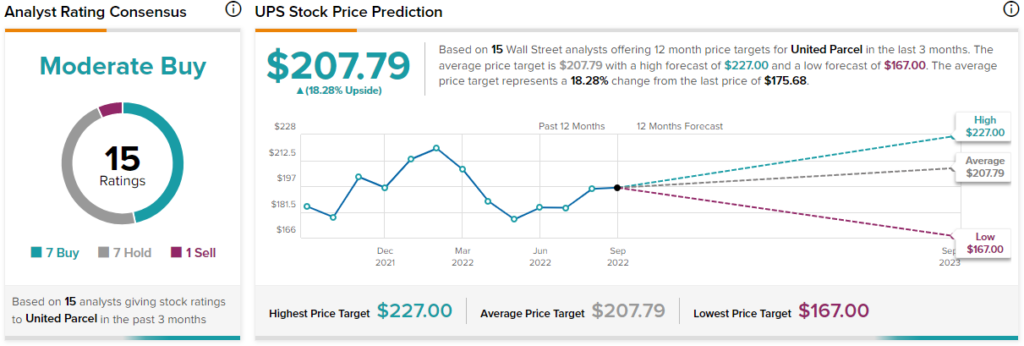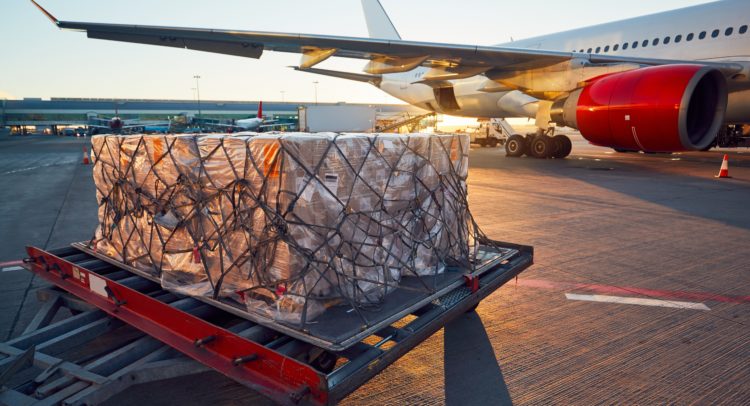Demand for container shipping is a sinking ship. Major ocean ports across the globe are logjammed, and ships are anchored for weeks, unable to move. The next best thing after ocean shipping? Air freight. With the demand for air freight likely to get a boost from the dwindling demand for ocean container shipping, logistics players with established air freight fleets like United Parcel (NYSE:UPS) and FedEx (NYSE:FDX) are likely to get a lift.
Don't Miss our Black Friday Offers:
- Unlock your investing potential with TipRanks Premium - Now At 40% OFF!
- Make smarter investments with weekly expert stock picks from the Smart Investor Newsletter
When the world was mostly stuck at home through 2020 and 2021, online shopping activity grew manifold. This put pressure on logistics companies which, at that point, mostly preferred ocean shipping rather than air mail. Port lockdowns and labor shortages during the pandemic made things worse.
As the world still reeled from the virus in 2022, online shopping momentum continued. Ports were jammed, trade in the technology sector was restricted, and the exchange of key technology items and components was delayed.
Now, as scores of container ships paint a grim picture at the ports, shipping companies that once disregarded air shipping as a more expensive shipping option are jumping on the air freight bandwagon. This is because there is trade that simply needs to be done and products that need to be shipped. This is expected to give a boost to air freight demand.
Understanding Air Freight Demand Trends
The International Air Transport Association calculated a 21% year-over-year growth in the air freight industry in 2021 and currently expects 4.4% growth this year.
Additionally, freight rates, which were already expensive, skyrocketed 200% year-over-year between January and April. Boeing says that 400 freight planes were added this year across the world. Right now, its global freight fleet strength is 2,000, and Boeing expects this number to increase to over 3,600 by 2040.
Even though the competition is intensifying in a market that is already bogged down by high fuel costs and expensive operations, bellwethers like United Parcel Service and FedEx are likely to get a boost from the surge in demand.
FedEx (FDX)
Delivery services giant FedEx is in the spotlight for the wrong reasons presently. The company recently warned of an aggravated slowdown in the global economy, which has taken a big bite into its first quarter of Fiscal 2023.
Its preliminary results highlighted the challenges faced by the company during the quarter and indicated that the downtrends are expected to continue through the second quarter as well. This sent pessimists purging FDX shares as well as shares of its rival, United Parcel Service.
Nonetheless, speaking like a true contrarian, the recent value destruction that FedEx has brought upon itself might have opened a good opportunity to buy the stock for the long term. The company had 675 aircraft at the end of Fiscal 2022. Shares of FedEx are likely to get a boost due to air freight demand.
Moreover, going back into FedEx’s history, 2018 had seen a slew of dismal results and guidance cuts which had sent its shares downward. However, shares started going up toward the end of 2019 and managed to surge 90% over the next year. Therefore, it is too early to say that this is the end for FedEx.
Is FedEx Stock a Buy, Hold, or Sell?
Wall Street is not ready to let go of FedEx yet, giving it a Moderate Buy consensus rating backed by 11 Buys and 11 Holds. FedEx’s average price target stands at $231.70, indicating upside potential of 47.2% from current price levels.

United Parcel Service (UPS)
United Parcel Service operates its air freight segment under its subsidiary UPS Airlines. As of February 2022, the company has an active fleet of 290 aircraft dedicated to freight services.
UPS’ environment-friendly approach to the movement of packages is noteworthy. Last year, UPS announced that it is aiming to achieve carbon neutrality across scope 1, 2, and 3 emissions in its global operations by 2050.
Moreover, UPS is also working to ensure that all its facilities are powered by renewable electricity by 2035. Moreover, 30% of the fuel running its global air fleet is expected to run on sustainable aviation fuel by 2035. These efforts are likely to attract the attention of activist investors who are concerned about the ESG (environmental, social, and governance) factors of a stock.
Also, earlier this month, at an investor event, the company reiterated its financial targets for the year. This means that the company is not likely to miss its guidance like FedEx is expected to.
What is the Forecast for UPS Stock?
In the wake of the slowdown in shipping demand and disappointing guidance by FedEx, Wall Street remains cautiously optimistic about UPS, with a Moderate Buy rating based on seven Buys, seven Holds, and one Sell.
The average UPS stock price prediction of $207.79 indicates 18.3% upside potential.

The Takeaway
The overall demand for shipping is under pressure now that a global recession is looming and prices have become exorbitantly high. Despite the increase in fuel costs that are likely to weigh on air freight profitability (unless the high prices make up for it), demand for the transport of goods by air is the only way for trade to continue.



















